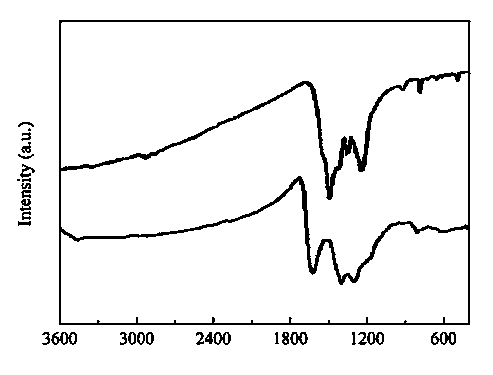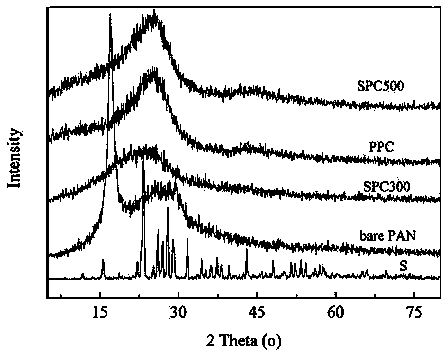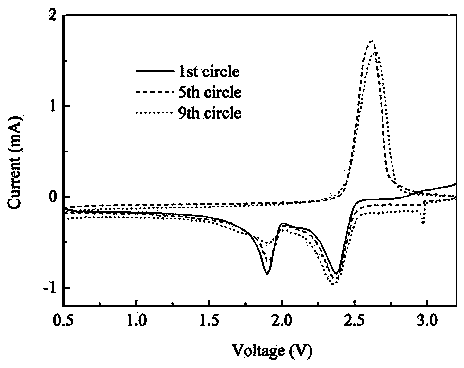Preparation method of sulfurized polyacrylonitrile anode material used for lithium secondary battery
A technology of vulcanized polyacrylonitrile and lithium secondary batteries, which is applied in the field of materials, can solve the problems of low sulfur content, poor reproducibility, etc., and achieve the effects of high capacitance, avoiding the generation of impurity phases, and easy access to raw materials
- Summary
- Abstract
- Description
- Claims
- Application Information
AI Technical Summary
Problems solved by technology
Method used
Image
Examples
Embodiment 1
[0034] Dissolve 1 g of polyacrylonitrile powder in 30 mL of dimethyl sulfoxide, stir magnetically for 20 minutes, add 4 g of sulfur powder, and then stir magnetically for 20 minutes. After the stirring is completed, the solution is placed in an oil bath at 200° C. for a heating reaction for 12 hours, so that polyacrylonitrile and sulfur are cross-linked and combined to form a homogeneous solution. After the reaction, the solution was transferred to a vacuum oven, and vacuum-dried at 80° C. for 1 hour to remove dimethyl sulfoxide in the solution to obtain a vulcanized polyacrylonitrile material precursor. Then transfer to the muffle furnace and fill with N 2 protection, heating to 450°C for carbonization for 4 hours, and natural cooling to obtain a vulcanized polyacrylonitrile material. As a reference group, 1 g of polyacrylonitrile powder was dissolved in 30 mL of dimethyl sulfoxide, but no sulfur powder was added. Then, according to the above processing flow, the pure polya...
Embodiment 2
[0037] Dissolve 10 g of polyacrylonitrile powder in 350 mL of dimethyl sulfoxide, stir magnetically for 30 minutes, add 45 g of sulfur powder, and then stir magnetically for 30 minutes. After the stirring is completed, the solution is placed in an oil bath at 250° C. for a heating reaction for 18 hours, so that polyacrylonitrile and sulfur are cross-linked and combined to form a homogeneous solution. After the reaction, the solution was transferred to a vacuum oven, and vacuum-dried at 80° C. for 2 hours to remove dimethyl sulfoxide in the solution to obtain a vulcanized polyacrylonitrile material precursor. Then transfer to the muffle furnace and fill with N 2 protection, heating to 500°C for carbonization for 6 hours, and natural cooling to obtain a vulcanized polyacrylonitrile material.
Embodiment 3
[0039] Take 5g polyacrylonitrile fiber, chop it and dissolve it in 150mL dimethyl sulfoxide, stir it magnetically for 45 minutes, add 25g sulfur powder, and stir it magnetically again for 45 minutes. After the stirring, the solution was placed in an oil bath at 250° C. for a heating reaction for 20 hours, so that polyacrylonitrile and sulfur were cross-linked and combined to form a homogeneous solution. After the reaction, the solution was transferred to a vacuum oven, and vacuum-dried at 80° C. for 1.5 hours to remove dimethyl sulfoxide in the solution to obtain a vulcanized polyacrylonitrile material precursor. Then transfer to the muffle furnace and fill with N 2 protection, heating to 450°C for carbonization for 5 hours, and natural cooling to obtain a vulcanized polyacrylonitrile material.
PUM
 Login to View More
Login to View More Abstract
Description
Claims
Application Information
 Login to View More
Login to View More - R&D
- Intellectual Property
- Life Sciences
- Materials
- Tech Scout
- Unparalleled Data Quality
- Higher Quality Content
- 60% Fewer Hallucinations
Browse by: Latest US Patents, China's latest patents, Technical Efficacy Thesaurus, Application Domain, Technology Topic, Popular Technical Reports.
© 2025 PatSnap. All rights reserved.Legal|Privacy policy|Modern Slavery Act Transparency Statement|Sitemap|About US| Contact US: help@patsnap.com



